YAMAHA YFM350R 2013 Owners Manual
Manufacturer: YAMAHA, Model Year: 2013, Model line: YFM350R, Model: YAMAHA YFM350R 2013Pages: 140, PDF Size: 2.95 MB
Page 101 of 140
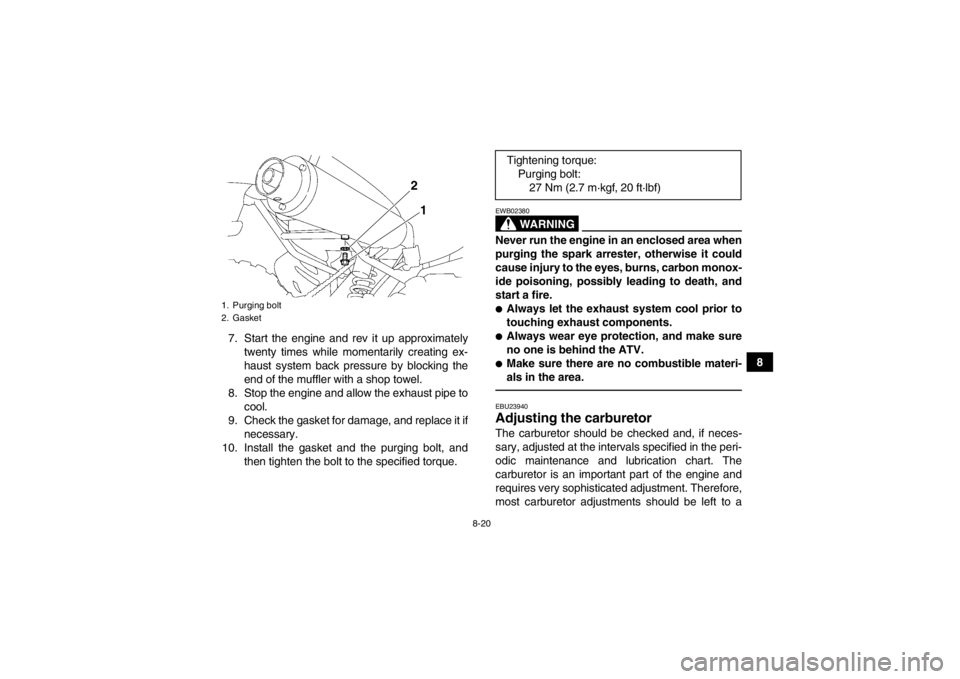
8-20
8
7. Start the engine and rev it up approximately
twenty times while momentarily creating ex-
haust system back pressure by blocking the
end of the muffler with a shop towel.
8. Stop the engine and allow the exhaust pipe to cool.
9. Check the gasket for damage, and replace it if necessary.
10. Install the gasket and the purging bolt, and then tighten the bolt to the specified torque.
WARNING
EWB02380Never run the engine in an enclosed area when
purging the spark arrester, otherwise it could
cause injury to the eyes, burns, carbon monox-
ide poisoning, possibly leading to death, and
start a fire.●Always let the exhaust system cool prior to
touching exhaust components.●Always wear eye protection, and make sure
no one is behind the ATV.●Make sure there are no combustible materi-
als in the area.EBU23940Adjusting the carburetor The carburetor should be checked and, if neces-
sary, adjusted at the intervals specified in the peri-
odic maintenance and lubrication chart. The
carburetor is an important part of the engine and
requires very sophisticated adjustment. Therefore,
most carburetor adjustments should be left to a
1. Purging bolt
2. Gasket
12
Tightening torque:Purging bolt:27 Nm (2.7 m·kgf, 20 ft·lbf)
U1BS63E0.book Page 20 Tuesday, March 13, 2012 11:43 AM
Page 102 of 140
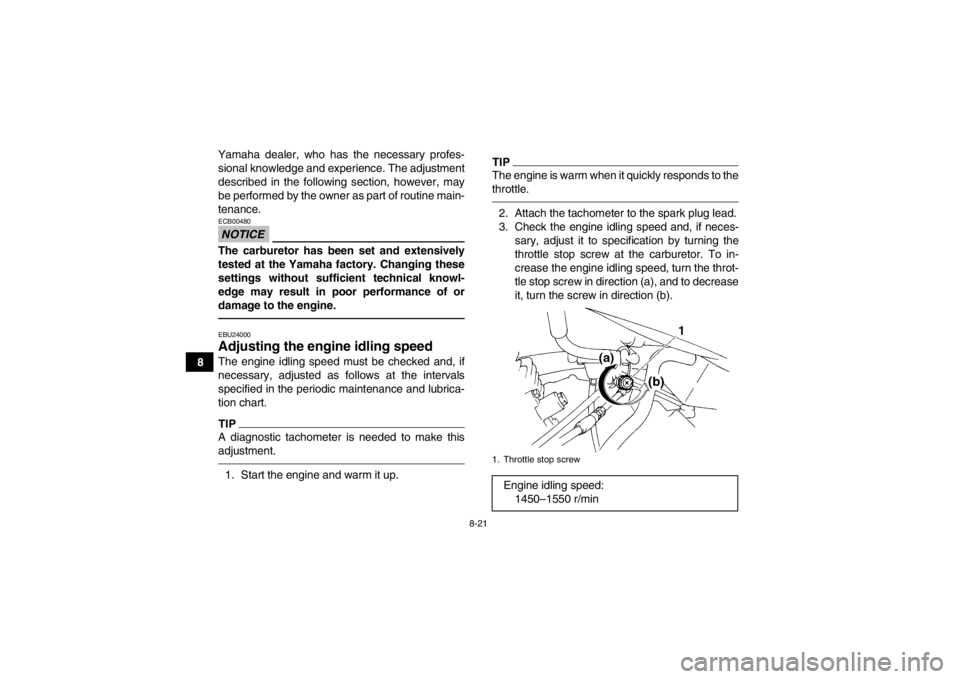
8-21
8Yamaha dealer, who has the necessary profes-
sional knowledge and experience. The adjustment
described in the following section, however, may
be performed by the owner as part of routine main-
tenance.
NOTICEECB00480The carburetor has been set and extensively
tested at the Yamaha factory. Changing these
settings without sufficient technical knowl-
edge may result in poor performance of or
damage to the engine.EBU24000Adjusting the engine idling speed The engine idling speed must be checked and, if
necessary, adjusted as follows at the intervals
specified in the periodic maintenance and lubrica-
tion chart.TIPA diagnostic tachometer is needed to make this
adjustment.1. Start the engine and warm it up.
TIPThe engine is warm when it quickly responds to the
throttle.2. Attach the tachometer to the spark plug lead.
3. Check the engine idling speed and, if neces- sary, adjust it to specification by turning the
throttle stop screw at the carburetor. To in-
crease the engine idling speed, turn the throt-
tle stop screw in direction (a), and to decrease
it, turn the screw in direction (b).1. Throttle stop screwEngine idling speed:1450–1550 r/min
U1BS63E0.book Page 21 Tuesday, March 13, 2012 11:43 AM
Page 103 of 140
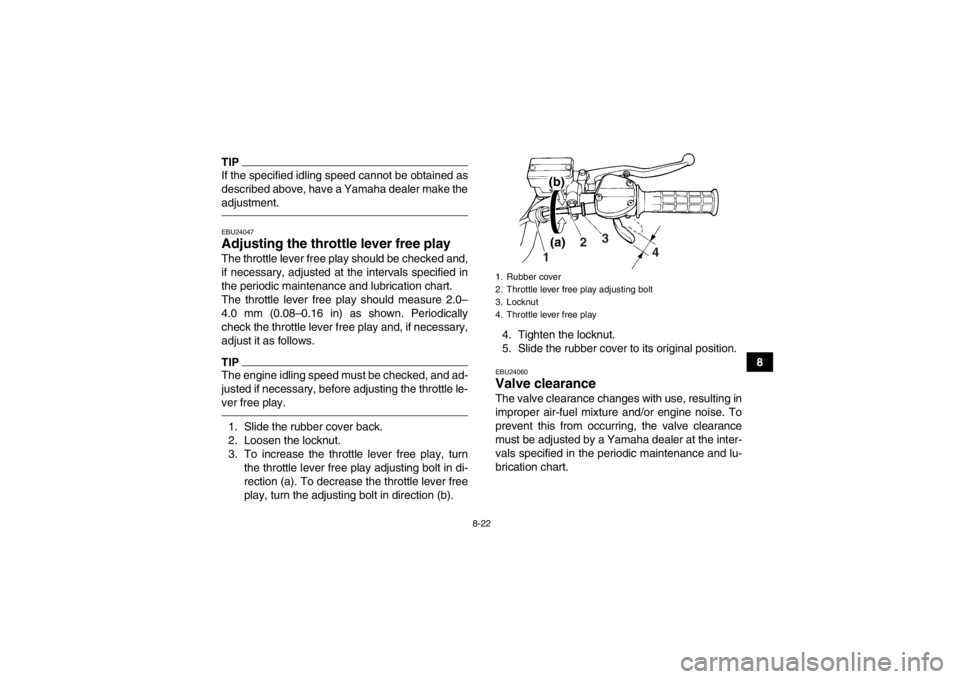
8-22
8
TIPIf the specified idling speed cannot be obtained as
described above, have a Yamaha dealer make the
adjustment.EBU24047Adjusting the throttle lever free play The throttle lever free play should be checked and,
if necessary, adjusted at the intervals specified in
the periodic maintenance and lubrication chart.
The throttle lever free play should measure 2.0–
4.0 mm (0.08–0.16 in) as shown. Periodically
check the throttle lever free play and, if necessary,
adjust it as follows.TIPThe engine idling speed must be checked, and ad-
justed if necessary, before adjusting the throttle le-
ver free play.1. Slide the rubber cover back.
2. Loosen the locknut.
3. To increase the throttle lever free play, turnthe throttle lever free play adjusting bolt in di-
rection (a). To decrease the throttle lever free
play, turn the adjusting bolt in direction (b). 4. Tighten the locknut.
5. Slide the rubber cover to its original position.
EBU24060Valve clearance The valve clearance changes with use, resulting in
improper air-fuel mixture and/or engine noise. To
prevent this from occurring, the valve clearance
must be adjusted by a Yamaha dealer at the inter-
vals specified in the periodic maintenance and lu-
brication chart.1. Rubber cover
2. Throttle lever free play adjusting bolt
3. Locknut
4. Throttle lever free play
3
1 2
4
U1BS63E0.book Page 22 Tuesday, March 13, 2012 11:43 AM
Page 104 of 140
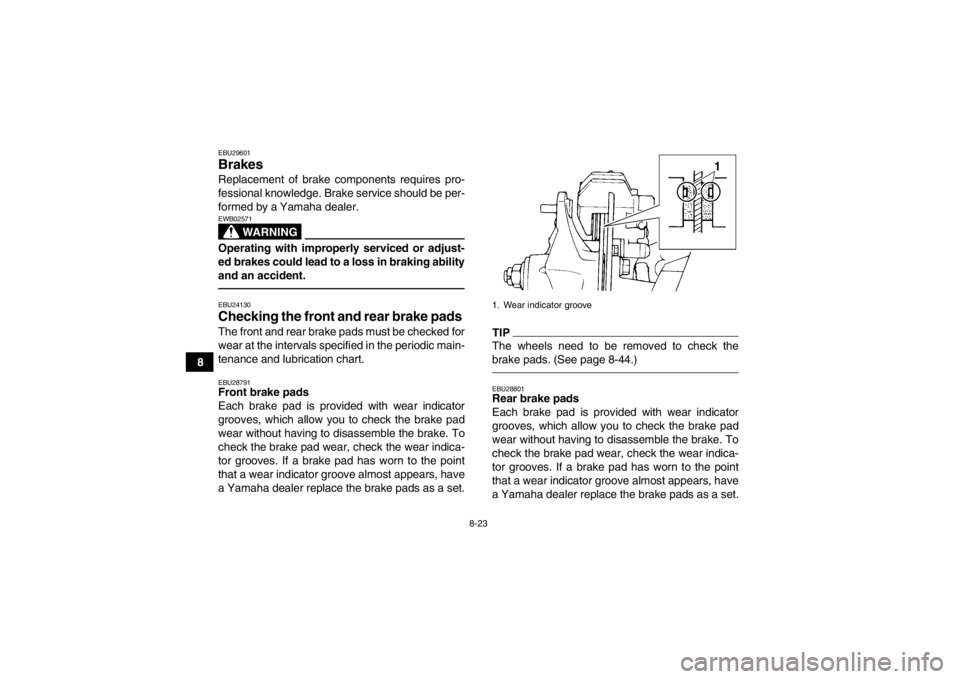
8-23
8
EBU29601Brakes Replacement of brake components requires pro-
fessional knowledge. Brake service should be per-
formed by a Yamaha dealer.
WARNING
EWB02571Operating with improperly serviced or adjust-
ed brakes could lead to a loss in braking ability
and an accident.EBU24130Checking the front and rear brake pads The front and rear brake pads must be checked for
wear at the intervals specified in the periodic main-
tenance and lubrication chart.EBU28791Front brake pads
Each brake pad is provided with wear indicator
grooves, which allow you to check the brake pad
wear without having to disassemble the brake. To
check the brake pad wear, check the wear indica-
tor grooves. If a brake pad has worn to the point
that a wear indicator groove almost appears, have
a Yamaha dealer replace the brake pads as a set.
TIPThe wheels need to be removed to check the
brake pads. (See page 8-44.)EBU28801Rear brake pads
Each brake pad is provided with wear indicator
grooves, which allow you to check the brake pad
wear without having to disassemble the brake. To
check the brake pad wear, check the wear indica-
tor grooves. If a brake pad has worn to the point
that a wear indicator groove almost appears, have
a Yamaha dealer replace the brake pads as a set.1. Wear indicator groove
U1BS63E0.book Page 23 Tuesday, March 13, 2012 11:43 AM
Page 105 of 140
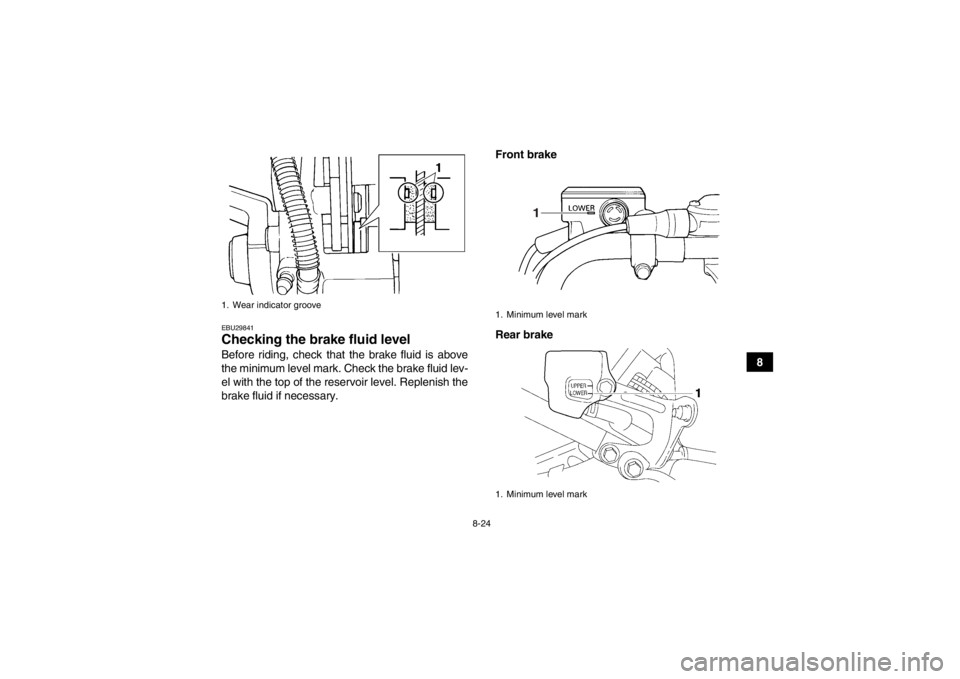
8-24
8
EBU29841Checking the brake fluid level Before riding, check that the brake fluid is above
the minimum level mark. Check the brake fluid lev-
el with the top of the reservoir level. Replenish the
brake fluid if necessary.Front brake
Rear brake1. Wear indicator groove
1. Minimum level mark
1. Minimum level mark
1
U1BS63E0.book Page 24 Tuesday, March 13, 2012 11:43 AM
Page 106 of 140
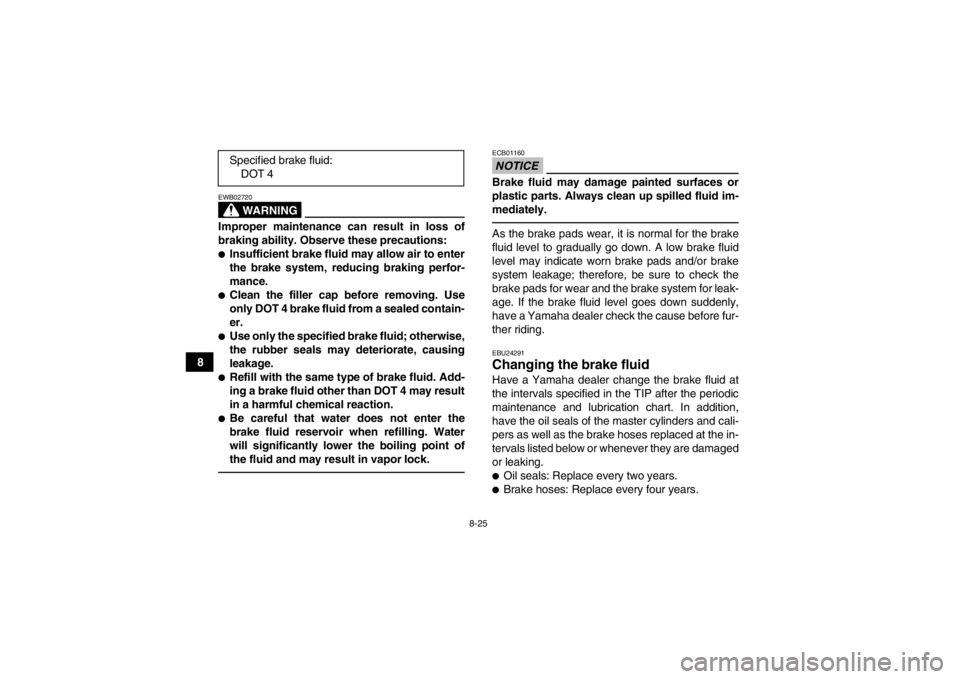
8-25
8
WARNING
EWB02720Improper maintenance can result in loss of
braking ability. Observe these precautions:●Insufficient brake fluid may allow air to enter
the brake system, reducing braking perfor-
mance.●Clean the filler cap before removing. Use
only DOT 4 brake fluid from a sealed contain-
er.●Use only the specified brake fluid; otherwise,
the rubber seals may deteriorate, causing
leakage.●Refill with the same type of brake fluid. Add-
ing a brake fluid other than DOT 4 may result
in a harmful chemical reaction.●Be careful that water does not enter the
brake fluid reservoir when refilling. Water
will significantly lower the boiling point of
the fluid and may result in vapor lock.
NOTICEECB01160Brake fluid may damage painted surfaces or
plastic parts. Always clean up spilled fluid im-
mediately.As the brake pads wear, it is normal for the brake
fluid level to gradually go down. A low brake fluid
level may indicate worn brake pads and/or brake
system leakage; therefore, be sure to check the
brake pads for wear and the brake system for leak-
age. If the brake fluid level goes down suddenly,
have a Yamaha dealer check the cause before fur-
ther riding.EBU24291Changing the brake fluid Have a Yamaha dealer change the brake fluid at
the intervals specified in the TIP after the periodic
maintenance and lubrication chart. In addition,
have the oil seals of the master cylinders and cali-
pers as well as the brake hoses replaced at the in-
tervals listed below or whenever they are damaged
or leaking.●Oil seals: Replace every two years.●Brake hoses: Replace every four years.
Specified brake fluid:
DOT 4
U1BS63E0.book Page 25 Tuesday, March 13, 2012 11:43 AM
Page 107 of 140
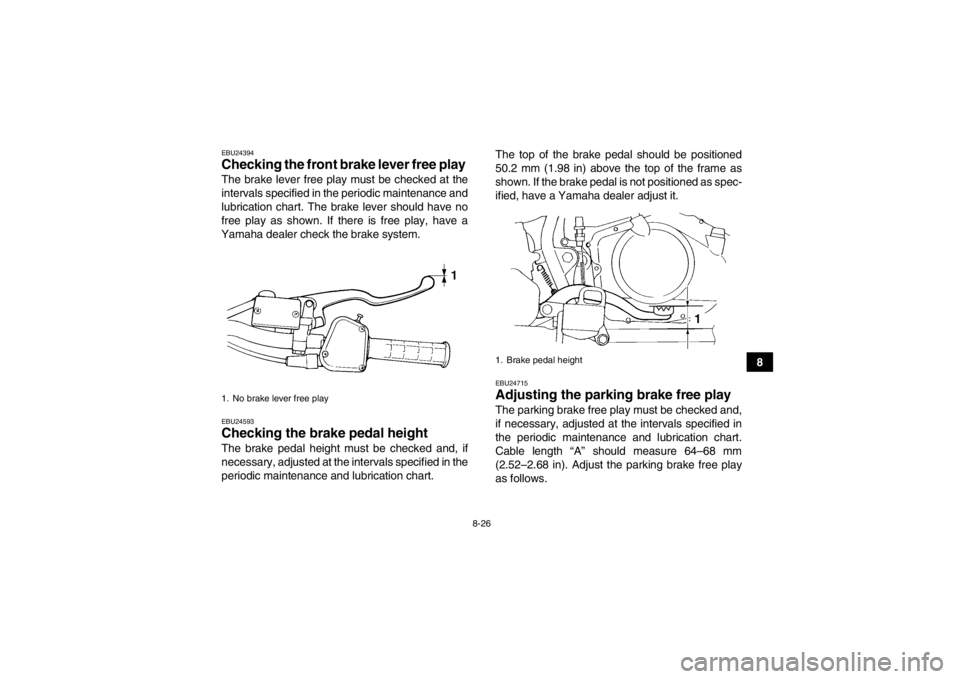
8-26
8
EBU24394Checking the front brake lever free play The brake lever free play must be checked at the
intervals specified in the periodic maintenance and
lubrication chart. The brake lever should have no
free play as shown. If there is free play, have a
Yamaha dealer check the brake system.EBU24593Checking the brake pedal height The brake pedal height must be checked and, if
necessary, adjusted at the intervals specified in the
periodic maintenance and lubrication chart. The top of the brake pedal should be positioned
50.2 mm (1.98 in) above the top of the frame as
shown. If the brake pedal is not positioned as spec-
ified, have a Yamaha dealer adjust it.
EBU24715Adjusting the parking brake free play The parking brake free play must be checked and,
if necessary, adjusted at the intervals specified in
the periodic maintenance and lubrication chart.
Cable length “A” should measure 64–68 mm
(2.52–2.68 in). Adjust the parking brake free play
as follows.
1. No brake lever free play
1. Brake pedal height
U1BS63E0.book Page 26 Tuesday, March 13, 2012 11:43 AM
Page 108 of 140
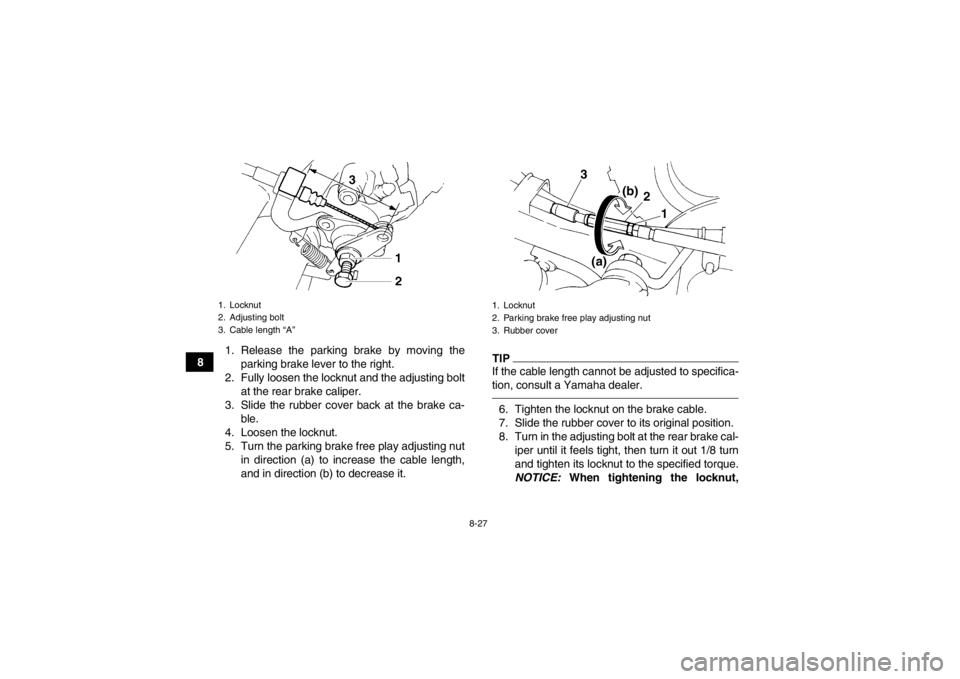
8-27
81. Release the parking brake by moving the
parking brake lever to the right.
2. Fully loosen the locknut and the adjusting bolt at the rear brake caliper.
3. Slide the rubber cover back at the brake ca- ble.
4. Loosen the locknut.
5. Turn the parking brake free play adjusting nut in direction (a) to increase the cable length,
and in direction (b) to decrease it.
TIPIf the cable length cannot be adjusted to specifica-
tion, consult a Yamaha dealer.6. Tighten the locknut on the brake cable.
7. Slide the rubber cover to its original position.
8. Turn in the adjusting bolt at the rear brake cal-iper until it feels tight, then turn it out 1/8 turn
and tighten its locknut to the specified torque.
NOTICE: When tightening the locknut,
1. Locknut
2. Adjusting bolt
3. Cable length “A”
1. Locknut
2. Parking brake free play adjusting nut
3. Rubber cover
1
2
(a) (b)
3
U1BS63E0.book Page 27 Tuesday, March 13, 2012 11:43 AM
Page 109 of 140
![YAMAHA YFM350R 2013 Owners Manual 8-28
8
hold the adjusting bolt with a wrench so
that it does not turn together with the lock-
nut.
[ECB00521]
WARNING
EWB02090Operating with improperly serviced or adjust-
ed brakes could cause the b YAMAHA YFM350R 2013 Owners Manual 8-28
8
hold the adjusting bolt with a wrench so
that it does not turn together with the lock-
nut.
[ECB00521]
WARNING
EWB02090Operating with improperly serviced or adjust-
ed brakes could cause the b](/img/51/53698/w960_53698-108.png)
8-28
8
hold the adjusting bolt with a wrench so
that it does not turn together with the lock-
nut.
[ECB00521]
WARNING
EWB02090Operating with improperly serviced or adjust-
ed brakes could cause the brakes to malfunc-
tion, resulting in reduced braking
performance. This could increase the chance
of a collision or accident. After adjusting the
parking brake free play, block the rear of the
ATV off the ground and spin the rear wheels.
Check to make sure there is no brake drag. If
brake drag is noticed, perform the adjustment
again.EBU24743Brake light switches The brake light, which is activated by the brake
pedal and brake lever, should come on just before
braking takes effect. The brake light switch for the brake pedal can be
adjusted as follows, but the front brake light switch
should be adjusted by a Yamaha dealer.
Turn the rear brake light switch adjusting nut while
holding the brake light switch in place. To make the
brake light come on earlier, turn the adjusting nut
in direction (a). To make the brake light come on
later, turn the adjusting nut in direction (b).
EBU30120Adjusting the clutch lever free play The clutch lever free play must be checked and, if
necessary, adjusted at the intervals specified in the
periodic maintenance and lubrication chart.
Tightening torque:
Locknut (rear brake caliper):16 Nm (1.6 m·kgf, 12 ft·lbf)1. Rear brake light switch
2. Rear brake light switch adjusting nut
U1BS63E0.book Page 28 Tuesday, March 13, 2012 11:43 AM
Page 110 of 140
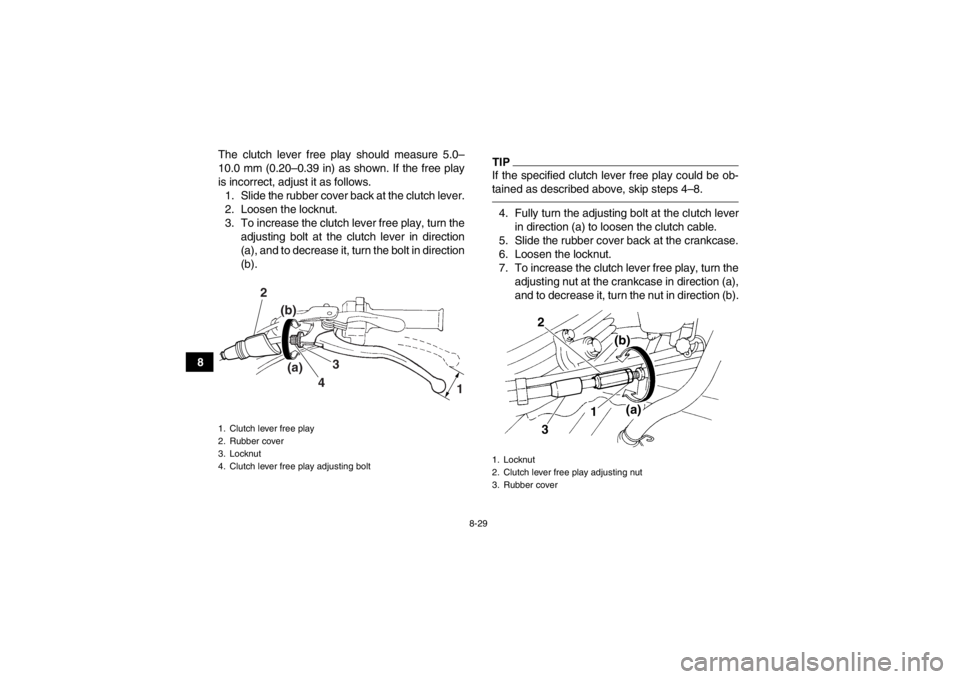
8-29
8The clutch lever free play should measure 5.0–
10.0 mm (0.20–0.39 in) as shown. If the free play
is incorrect, adjust it as follows.
1. Slide the rubber cover back at the clutch lever.
2. Loosen the locknut.
3. To increase the clutch lever free play, turn the adjusting bolt at the clutch lever in direction
(a), and to decrease it, turn the bolt in direction
(b).
TIPIf the specified clutch lever free play could be ob-
tained as described above, skip steps 4–8.4. Fully turn the adjusting bolt at the clutch leverin direction (a) to loosen the clutch cable.
5. Slide the rubber cover back at the crankcase.
6. Loosen the locknut.
7. To increase the clutch lever free play, turn the adjusting nut at the crankcase in direction (a),
and to decrease it, turn the nut in direction (b).
1. Clutch lever free play
2. Rubber cover
3. Locknut
4. Clutch lever free play adjusting bolt
3
2
4
(a)
(b)
1
1. Locknut
2. Clutch lever free play adjusting nut
3. Rubber cover
2
(a)
(b)
3
1
U1BS63E0.book Page 29 Tuesday, March 13, 2012 11:43 AM